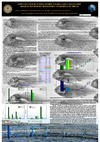Please use this identifier to cite or link to this item:
https://accedacris.ulpgc.es/handle/10553/12417
| Título: | Effect of culture system and diet in early larval stages over skeletal deformities development in gilthead sea bream | Autores/as: | Roo, Javier Izquierdo, Marisol Hernandez-Cruz, C.M Socorro Cruz, Juan Antonio Fernandez-Palacios, H. |
Clasificación UNESCO: | 251092 Acuicultura marina | Fecha de publicación: | 2004 | Resumen: | Main deformities such as lordosis, opercular deformities and upper/lower jaws shortening are considered as quality descriptors in commercial marine fish fry production and seem to be related with larval culture conditions in early larval stages. The aim of this work was to obtain information about the contribution of the diet and rearing system to the apparition of these abnormalities in gilthead sea bream (Sparus aurata) larvae in semi-industrial scale facilities. For that purpose, two different larval rearing systems semi-intensive and intensive were compared; besides, two different rotifer enrichments, DHA Protein Selco, (Inve Aquaculture, Dendermonde, Belgium) (R1) and Red Pepper Paste, (Bernaqua bvba, Turnhout, Belgium) were tested in the intensive system. Biochemical composition of larvae, preys and commercial products was analysed. At 50 days post hatching six hundred fish per treatment were individually studied under stereoscope and deformity frequency recorded. Besides at 95 days post hatching fry were soft X ray monitored. Both rotifer enrichment and rearing system affected survival, growth and deformity frequency. Rearing system did not affect total larvae fatty acid content except at 20 dah, where DHA were significantly higher and EPA significantly lower in Semi-intensive system. A significantly lower percentage of deformity rates together with better survival and growth were obtained in the semi-intensive system. In dietary treatment, rotifer enrichment significantly affected larval survival. R1 rotifers enrichment significantly (P<0.05) improved survival when compared to fed R2 larvae. The content of DPA was significantly (P<0.05) higher in R2 fed larvae reflecting the R2 rotifers content of this fatty acid. The level of this FA tended to decrease in concordance with the rotifers replacement by artemia in the diet. The effects n-3-HUFA and DPA (22:5n-6) over larval survival and skeletal deformities development is discussed. | URI: | https://accedacris.ulpgc.es/handle/10553/12417 | Fuente: | XI International Symposium on Nutrition and Feeding in Fish. 2004. Phuket, Thailand |
| Colección: | Póster de congreso |
Visitas
57
actualizado el 08-jul-2023
Descargas
34
actualizado el 08-jul-2023
Google ScholarTM
Verifica
Comparte
Exporta metadatos
Este elemento está sujeto a una licencia Licencia Creative Commons

